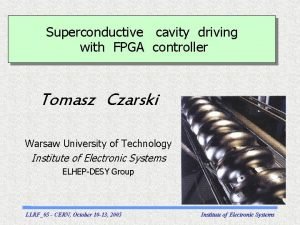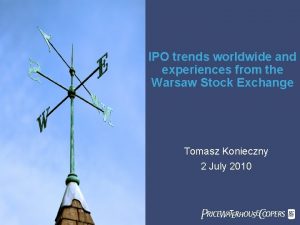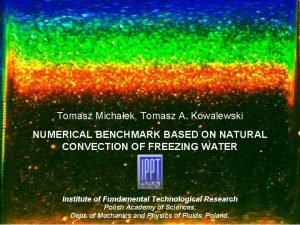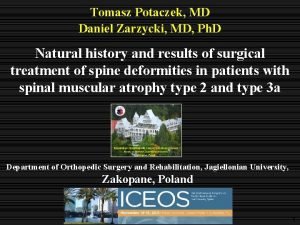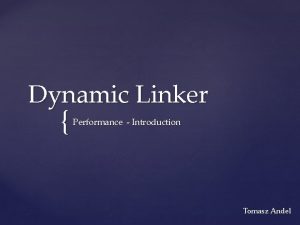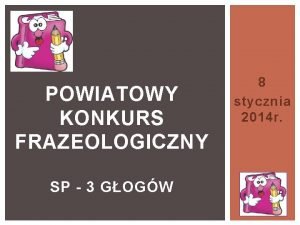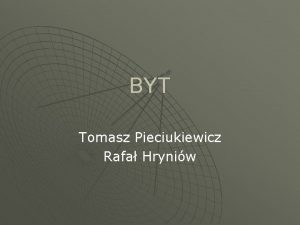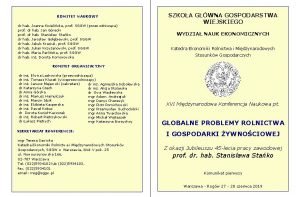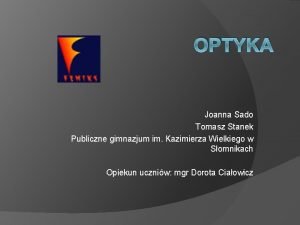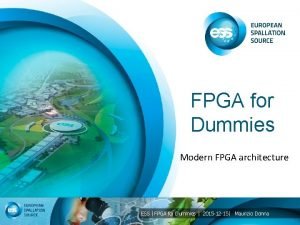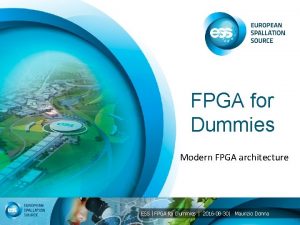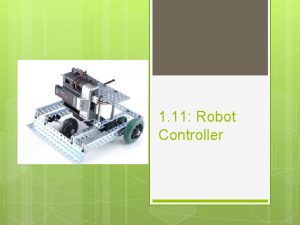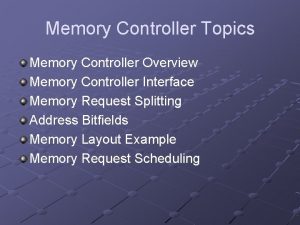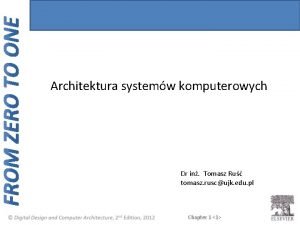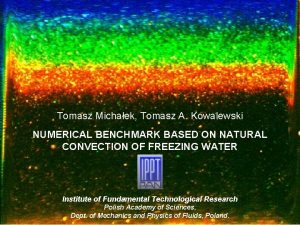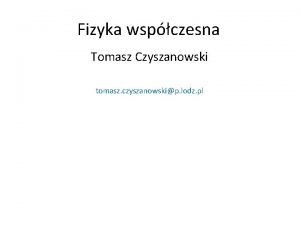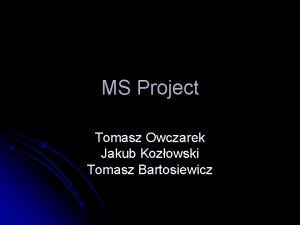Superconductive cavity driving with FPGA controller Tomasz Czarski







![Implementation of parameters estimation for adaptive control of pulsed operated cavity Parameters identification [F]n Implementation of parameters estimation for adaptive control of pulsed operated cavity Parameters identification [F]n](https://slidetodoc.com/presentation_image_h/1fdcb6818f3452704f7c0811b67bb52e/image-8.jpg)








- Slides: 16

Superconductive cavity driving with FPGA controller Tomasz Czarski Warsaw University of Technology Institute of Electronic Systems ELHEP-DESY Group LLRF_05 - CERN, October 10 -13, 2005 Institute of Electronic Systems

Main topics • • Low Level RF control system introduction Superconducting cavity modeling Cavity features Recognition of real cavity system Cavity parameters identification Control system algorithm Experimental results LLRF_05 - CERN, October 10 -13, 2005 Institute of Electronic Systems

Functional block diagram of Low Level Radio Frequency Cavity Control System CAVITY RESONATOR and ELECTRIC FIELD distribution FIELD SENSOR COUPLER KLYSTRON VECTOR MODULATOR DAC CAVITY ENVIRONS ANALOG SYSTEM PARTICLE DOWNCONVERTER 250 k. Hz MASTER OSCILATOR 1. 3 GHz FPGA I/Q DETECTOR FPGA CONTROLLER CONTROL ADC DIGITAL BLOCK CONTROL SYSTEM PARAMETERS IDENTIFICATION LLRF_05 - CERN, October 10 -13, 2005 SYSTEM Institute of Electronic Systems

Superconductive cavity modeling RF current CAVITY transfer function RF voltage I(s–iωg) Z(s) = (1/R+ s. C+1/s. L)-1 Z(s)∙I(s–iωg) Modulation Analytic signal: a(t)·exp[i(ωgt + φ(t))] Demodulation exp(iωgt) Complex envelope: a(t)·exp[iφ(t)] = [I, Q] exp(-iωgt) Input signal Low pass transformation Z(s+iωg) ≈ ω1/2·R/(s +ω1/2– i∆ω) half-bandwidth = ω1/2 detuning = ∆ω Output signal I(s)↔i(t) Z(s+iωg)∙I(s)↔v(t) State space – continuous and discrete model dv/dt = A·v + ω1/2·R·i A = -ω1/2+i∆ω LLRF_05 - CERN, October 10 -13, 2005 vn = E·vn-1 + T·ω1/2·R·in-1 E = (1 -ω1/2·T) + i∆ω·T Institute of Electronic Systems

Cavity features Particle Field sensor Coupler Carrier frequency Pulse time Repetition time Field gradient Beam pulse repetition Average beam current 1. 3 GHz 1. 3 ms 100 ms 25 MV/m 1µs 8 m. A Cavity parameters: Resonance frequency Characteristic resistance ω0 = (LC)-½ 2π· 1. 3 GHz ρ = (L/C)½ 520 Ω LLRF_05 - CERN, October 10 -13, 2005 resonance circuit parameters: RLC Quality factor Half-bandwidth Detuning Q = R/ρ ω1/2 = 1/2 RC 2π· 215 Hz ∆ω = ω0 - ωg ~ 2π· 600 Hz 3· 106 Institute of Electronic Systems

Algebraic model of cavity environment system Internal CAVITY model Input distortion factor vk = Ek-1·vk-1 + uk-1 - (ub)k-1 D Input phasor u + u 0 + u’ 0 D’ Output distortion factor E = (1 -ω1/2·T) + i∆ω·T C CAVITY environs Input offset phasor Input offset compensator Input calibrator v FPGA controller area Output calibrator Output phasor C’ v’ External CAVITY model u’ v’k = Ek-1·v’k-1 + C·C’·D·[D’·u’k-1 + u’ 0 + u 0)] – C·C’·(ub)k-1 LLRF_05 - CERN, October 10 -13, 2005 Institute of Electronic Systems

Parameters identification of cavity system in noisy and no stationary condition External CAVITY model vk+1 = Ek·vk + Fk·uk Ek = (1 - ω1/2·T) + i∆ωk·T Linear decomposition of no stationary parameter Y: Y = W*x W – matrix of base functions: polynomial or cubic B-spline set x – unknown vector of series coefficients Over-determined matrix equation for measurement range: V = Z*z V – total output vector, Z – total structure matrix z – total vector of unknown values Least square (LS) solution: z = (ZT*Z)-1*ZT*V LLRF_05 - CERN, October 10 -13, 2005 Institute of Electronic Systems
![Implementation of parameters estimation for adaptive control of pulsed operated cavity Parameters identification Fn Implementation of parameters estimation for adaptive control of pulsed operated cavity Parameters identification [F]n](https://slidetodoc.com/presentation_image_h/1fdcb6818f3452704f7c0811b67bb52e/image-8.jpg)
Implementation of parameters estimation for adaptive control of pulsed operated cavity Parameters identification [F]n Static [U]n [E]n Dynamic [V]n [vk+1 = Ek·vk + Fk·uk]n [U]n+1 Inverse [V 0] solution RANGE SIGNAL CONDITION ASSUMPTION ESTIMATED VALUE DECAY u = 0, ub = 0 – ω1/2 and [∆ω] FILLIG ub = 0 arg(F) = 0, ω1/2 = const. [|F|] and [∆ω] FLATTOP ub = 0 [∆ω] – linear, ω1/2 = const. [F] LLRF_05 - CERN, October 10 -13, 2005 Institute of Electronic Systems

Functional black diagram of FPGA controller and control tables determination FPGA CALIBRATION CONTROLLER – + + FEED-FORWARD TABLE C O N T R O L Filling Cavity is driven in resonance condition Flattop Envelope of cavity voltage is stable GAIN TABLE CALIBRATION & FILTERING I/Q DETECTOR SET-POINT TABLE FEED-FORWARD SET-POINT i(t) = Io·exp(iφ(t)) dφ(t)/dt = (t) v(t) = i(t)·R(1– exp(-ω1/2·t)) i(t) = V 0·(1 -iΔω(t)/ω1/2)/R v(t) = V 0·exp(iΦ 0) LLRF_05 - CERN, October 10 -13, 2005 Institute of Electronic Systems

Functional diagram of cavity testing system CAVITY SYSTEM FPGA SYSTEM CONTROLLER u MEMORY v CONTROL DATA PARAMETERS IDENTIFICATION CAVITY MODEL ≈ MATLAB SYSTEM LLRF_05 - CERN, October 10 -13, 2005 Institute of Electronic Systems

Adaptive feed-forward cavity driving first step of iterative procedure – real process LLRF_05 - CERN, October 10 -13, 2005 Institute of Electronic Systems

Adaptive feed-forward cavity driving second step of iterative procedure – MATLAB simulation LLRF_05 - CERN, October 10 -13, 2005 Institute of Electronic Systems

Feed-forward cavity driving CHECHIA cavity and model comparison LLRF_05 - CERN, October 10 -13, 2005 Institute of Electronic Systems

Feedback cavity driving CHECHIA cavity and model comparison LLRF_05 - CERN, October 10 -13, 2005 Institute of Electronic Systems

CONCLUSION • Cavity model has been confirmed according to reality • Cavity parameters identification has been verified for control purpose LLRF_05 - CERN, October 10 -13, 2005 Institute of Electronic Systems

Future plans • Vector sum control with beam • Forward and reflected signal application for control purpose • Normal-conductive cavity control for RF Gun LLRF_05 - CERN, October 10 -13, 2005 Institute of Electronic Systems
 Tomasz czarski
Tomasz czarski Body cavities labeled
Body cavities labeled Peritoneal.cavity
Peritoneal.cavity Peritoneum
Peritoneum Ventral cavity
Ventral cavity Which membrane encloses the abdominopelvic viscera?
Which membrane encloses the abdominopelvic viscera? Tomasz konieczny pwc
Tomasz konieczny pwc Ogniem i mieczem ilustracje
Ogniem i mieczem ilustracje Tomasz cieciura
Tomasz cieciura Kowalewski
Kowalewski Daniel zarzycki
Daniel zarzycki Tomasz andel
Tomasz andel Dzielić skórę na niedźwiedziu związek frazeologiczny
Dzielić skórę na niedźwiedziu związek frazeologiczny Tomasz pieciukiewicz
Tomasz pieciukiewicz Tomasz klusek sggw
Tomasz klusek sggw Sghsgh
Sghsgh Piotr obserwuje monetę leżącą na dnie szklanki z wodą
Piotr obserwuje monetę leżącą na dnie szklanki z wodą
